
- Is there such an operation called “Operation Pleime-Chupong B-52 Strike”?
= Yes. That’s the code name given to the B-52 Strike Operation used in direct tactical support of the First Cavalry Division’s fight in the Ia Drang Valley in November 1965 ̣(Air Force Historical Studies Office):
These B-52s were used primarily in saturation bombing of Viet Cong base areas, but later they were used in direct tactical support of […] the First Cavalry Division’s fight in the Ia Drang Valley.
- Who coined that name?
= Brigadier General J.A. McChristian, J-2/MACV, when he wrote his report on, Intelligence Aspect of Plei Me/Chu Pong Campaign (20 October to 20 November 1965).
General McChristian says that the campaign started in Pleime on October 20 (page 6):
The Chu Pong base was known to exist well prior to the Pleime attack and J2 MACV had taken this area under study in September 1965 as a possible B-52 target.
and he indicates on the map where the B-52's struck in Chupong on November 18.
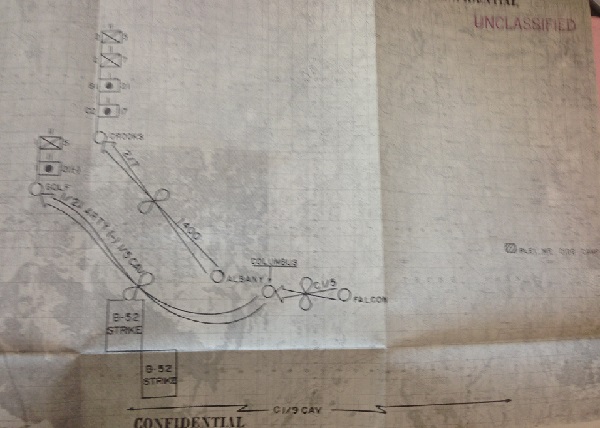
This code name is known only within the COMUSMACV circle; outside of it (CINCPAC, JGS, Defense Department, State Department), it is known as the Arc Light operation in tactical support of Operation Silver Bayonet I at Ia Drang Valley.
- Where can one find a copy of this document?
= At the US Army Heritage & Education Center - The US Army, Military History Institute - The US Army War College Library, Carlisle, PA 17013.
- What are the other known Arc Light operations in its early days of the Vietnam War?
= The first one code-named Arc Light I operation took place on 18 June 1965 (MACV: The Years of Escalation, 1962-1967):
The first B-52 raid, code-named Arc Light I, took place on 18 June [1965], against a suspected concentration of Viet Cong troop concentration in War Zone D, forty miles north of Saigon.
= the Ho Bo Woods Arc Light operation that was scheduled to take place on 17 September 1965 but was aborted by the State Department (General Westmoreland’s history notes):
Saturday, 18 September: We had hoped to have a B-52 strike on the morning of 17 September to support an operation of the 173d Brigade but at 11 p.m. the evening before it was cancelled. The strike was requested based on some excellent intelligence and I took a personal interest to insure that a nearby village would not endangered. We were under the impression that strike had been approved and had planned accordingly until we heard that the State Department had disallowed it.
= the first Arc Light operation used as tactical support to the 1st Air Cavalry Division conducting Operation Silver Bayonet I at Ia Drang Valley in November 1965 (classified as-code named 'Pleime-Chupong campaign').
= the second Arc Light operation used as tactical support to the Marine Corps’ Operation Harvest Moon in December 1965 (Harvest Moon operation Dec 1965):
On the afternoon of the 11th, Platt was visited by Brigadier General William DePuy, General Westmoreland's J-3, who suggested that USAF B-52s from Guam could strike the objective area before the Marines entered. General Platt accepted the offer and the first of several B-52 raids occurred on the morning of the 12th.
= and the most talked about Niagara Arc Light operation at Khe Sanh in 1968.
However, COMUSMACV has actually been executing a fairly amounts of B-52 strikes in the year of 1965: one mission in June, 6 missions in July, 10 missions in August, 20 missions in September, 23 missions in October, 39 missions in November, and 39 missions in December (Project CHECO report, Arc Light 1965-1966, 15 Sep 67).
- How was the Pleime-Chupong Arc Light operation different from the other Arc Light tactical support operations?
Two differences:
= One, in the general cases, the planning was done by COMUSMACV who then notified the ARVN Corps Commander of the execution; while in this particular case, the planning was done by II Corps Command who then notified COMUSMACV for the execution.
= Two, in the general cases, the purpose of the strikes was either of strategic nature to disrupt enemy bases, or of tactical nature in support of ground forces; while in this particular case, the B-52 strike was used as the main thrust, supported by the ground force used as the secondary thrust.
- Who was the mastermind of the Pleime-Chupong Arc Light operation?
= Colonel Hieu, II Corps Chief of Staff. He provided the operational concept and the intelligence of the entire operation. He coordinated the operational team comprising Brigadier General William DePuy, J-3/MACV, Major General Richard Larsen, IFFV Commander, and Brigadier General Richard Knowles, 1st Air Cavalry Division Forward Commander. General DePuy coordinated with the SAC in the execution of the B-52 strikes. The deployment and maneuvering of the 1st Air Cavalry Division units during the preparatory phase (Long Reach operation) were assumed by Brigadier General Knowles, 1st Air Cav Div Forward Commander (operational command) and Major General Larsen, IFFV Commander (operational control). It was closely monitored by General Westmoreland at MACV and by General Ngo Duc Thang and General Nguyen Huu Co (J3 and Chief of Operations respectively) at the Joint General Staff.
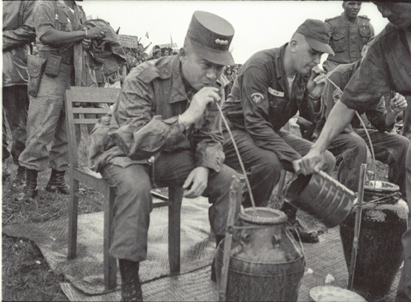
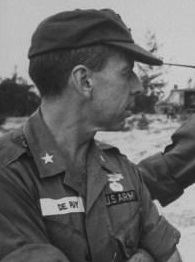
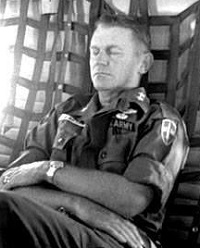
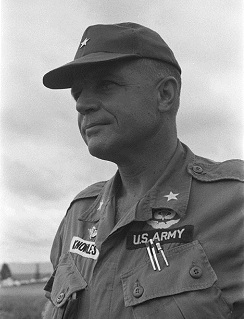
- Under what protocol was the operation carried out?
= The modus operandi of the operation was set by II Corps Command: Joint intelligence and support activities, commonly-shared concept of operations and results, separate TAOR, command, deployment of forces, conduct of activities, reserve (Why Pleime, chapter VIII):
In phase III, the operations had been conducted through a close cooperation between ARVN and US Forces: that was the latest procedure ever put into application since the second World War. It is characterized by: Joint intelligence and support activities; Commonly-shared concept of operations and results; Separate TAOR; Separate command; Separate deployment of forces; Separate conduct of activities; Separate reserve.
- How was the working relationship of the ARVN-US team?
= It was, according to General Westmoreland, “The effectiveness of this highly organized, closely integrated, cooperative effort has not often been emulated in modern warfare” (Why Pleime, Preface). General Westmoreland took the matter into his hands in not allowing any manipulative attempts from either side (General Westmoreland’s History Notes):
Sunday, 17 October- I was concerned about reports that General Vinh Loc of II Corps was proceeding on his own without coordinating with American forces.
He also clamped down on any “prima donna” complex behaviors (General Westmoreland’s History Notes):
Saturday, 6 November- During the course of the day I had a chance to talk to General Larsen, Colonel Mataxis and General Kinnard. I congratulated General Kinnard on the successes being achieved by elements of his division in Pleiku and made the passing observation that they were apparently getting over their prima donna complex.
- How closely did General Westmoreland supervise the execution of this operation?
= Throughout the Pleime-Chupong campaign, General Westmoreland paid frequent visits to the various headquarters at corps, division, brigade, and battalion levels - to have the first hand grasp of the situation at all time (General Westmorland’s History Notes (29 August-29 November 1965)"): on 19 October, 1st Air Cavalry Division Officers; on 28 October, Lt Colonel Clark, 1st Air Cavalry Brigade; on 31 October, General Larsen, IFFV; on 6 November, General Kinnard, 1st Air Cavalry Division; on 18 November, Lieutenant Colonel Hal Moore, 1/7 Air Cavalry Battalion, and Colonel Tim Brown, 3rd Air Cavalry Brigade, and General Vinh Loc, II Corps and General Larsen, IFFV; on 25 November, ARVN Airborne Task Force, and 2nd Air Cavalry Brigade at Duc Co.
When it was over, he gave a first handed outline of the campaign (Preface, Why Pleime):
From the standpoint of employment of joint forces, the Plei Me battle was a classic. The signal successes of the latter phases could, perhaps, never have been realized had it not been for the judgment and foresight of Vietnamese leadership. The initial preparatory effort on the ground, paving the way for the introduction of the 1st Air Cavalry Division, was accomplished by Vietnamese forces. Similarly the very successful final phase exploitation was accomplished largely by the Vietnamese Airborne Brigade. The effectiveness of this highly organized, closely integrated, cooperative effort has not often been emulated in modern warfare.
- Did General William DePuy write an AAR of this operation?
= Unlike General McChristian, J-2/MACV, General DePuy did not seem to have left any written record of his participation in the Pleime-Chupong Arc Light operation.
This fact, coupled with General Westmoreland’s silence on the Arc Light action at Chupong in his History Notes, has led historians to conclude that there is no such operation as planned by a joint ARVN (Colonel Hieu) - US (Brigadier General DePuy) team.
- Is there an official record that indicates General DePuy’s involvement in this operation by name?
= Yes, in the G3 Journal/IFFV (G3 Journal/IFFV, 11/15/65):
10:30H: MAVC J3 (Gen DePuy) Gen DePuy called Col Barrow and asked if Arc Light had been cleared with CG II Corps. Col Barrow replied yes, CG II Corps has approved Arc Light. Target area approved by Col Barrow and Col McCord. Also Gen DePuy wanted to know if the elem of 1st Cav had received the 151600H restriction on not going west of YA grid line. Col Barrow informed Gen De Puy that the 1st Cav had acknowledged receipt of the restriction and would comply. Gen DePuy personally changed target configuration. Gen DePuy stated that this is the fastest a strike of this nature had ever been laid-on.
- Where can one discover such a plan?
= Firstly, in General McChristian’s Intelligence Aspect of Plei Me/Chu Pong Campaign, which shows the time-frame of the coordination between the B-52 strike and 1st Air Cavalry from the beginning at Pleime to the end at Chupong. And secondly, in General Vinh Loc’s Why Pleime and Pleime, Trận Chiến Lịch Sử, in General Kinnar’s Pleiku Campaign, and in General Larsen’s G3 Journal/IFFV, which depicts the various aspects of the combined B-52 strike-1ACD operation.
- What was the initial plan of the Arc Light operation at Chu Pong?
= The initial plan was studied in September 1965, long before the siege of the Pleime camp (Intelligence Aspect of Pleime/ Chu Pong Campaign, page 6):
The Chu Pong base was known to exist well prior to the Pleime attack and J2 MACV had taken this area under study in September 1965 as a possible B-52 target.
The plan studied the feasibility of using B-52 strike to destroy the three NVA Regiments – 32nd, 33rd, and 66th - coming down from the North, as they regrouped in assembly areas in the Chupong Massif to stage for an attack of the Pleime camp. The NVA B3 Field Front was planning to launch the attack by December 1965: the 32nd Regiment was already operating in the Central Highlands since January; the 33rd Regiment started operating in September; and the 66th Regiment would close in by mid-November.
Thus the initial operation code-named Chupong operation (Forward, Intelligence Aspect of Pleime/Chupong Campaign):
When it became apparent that during the Chu Pong Campaign a sizeable battle was in the making, the ACofS, J2, requested the field forces to maintain accurate records of actions taken and results thereof for inclusion in an after-action report.
was scheduled to enter in action by December 1965.
- Why was it renamed Pleime-Chupong campaign?
= When the NVA B3 Field Front decided to advance the attack of the Pleime camp to October 20 with only two readied Regiments – 32nd and 33rd – while the 66th was still on its way down the Ho Chi Minh trail, II Corps Command had to put on hold the B-52 strike until the arrival of the 66th Regiment and to adjust its plan accordingly. Now the plan had two phases. The Pleime phase: to interdict the enemy’s attack at Pleime; and the Chupong phase: to repulse the two attacking regiments back to Chupong. The Chupong phase introduced the supportive role assumed by the 1st Air Cavalry Division in rounding up and fixing the enemy units into targets available for B-52 strikes.
On October 27, when the Dan Thang 21 operation was wrapping up, II Corps Command assigned to the 1st Air Cavalry Division the conduct of the Long Reach (Trường Chinh) operation which unfolded in two subsequent operations: All the Way conducted by the 1st Air Cavalry Brigade from October 27 to November 9, and Silver Bayonet I conducted by the 3rd Air Cavalry Brigade from November 9 to 17. II Corps Command assumed the operational control of this operation through General Larsen, IFFV Commander.
How were the enemy troops set up into becoming targets available for B-52 strikes?
= Firstly, after the attacking troops retreat to Chupong, and knowing the enemy was earger for revenge (Pleime, Trận Chiến Lịch Sử, page 94):
With Dan Thang 21 operation finished, the Pleime camp was back on its footing, but among the two VC Regiments that had joined in the attack, we only inflicted 400 kills upon the enemy. The withdrawal was a rational and intelligent initiative taken by the VC Field Front Command. But the enemy would attempt to take revenge and the remote Pleime camp remains an eyesore to them.
II Corps kept the Pleime camp under its responsibility so that it still appeared weak and vulnerable and thus still tempting to the enemy’s palate (G3 Journal/IFFV, 10/30/65):
- 00:50H: II Corps (Major Black) - At 292350 Col Williams called Col Hieu, CofS II Corps. II Corps requested that 1st Cav TAOR be extended to include the Plei Me area except the camp itself. From present line on NS grid line ZA14 east to NS grid line AR77, on EW grid line ZA/AR15, south on AR77 to EW grid line 00, then west to NW grid line ZA14. Col Buchan, Gen Knowles, Col Williams and Col Mataxis agree.
= Secondly, after the 1st Air Cavalry Brigade succeeded in herding the two 32nd and 33rd Regiments back to Chupong, the 3rd Air Cavalry Brigade was ordered to switch the operational direction from west to east to entice the three 32nd, 33rd and 66th Regiments into regrouping in assembly areas in order to stage an attack of the Pleime camp for the second time (Pleiku Campaign, page 67, 76, 76):
By this time Field Force Vietnam had asked the division to consider moving this operation east of Pleime. The movement and shift in emphasis from west to east were to further stimulate a forthcoming decision from the NVA division headquarters. With American units seemingly withdrawing to the east of Pleime, the decision was to attempt to regain its early advantage with an attack. The target once again was the Pleime CIDG Camp. The division headquarters set the date for attack at 16 November, and issued orders to its three regiments.
= Thirdly, due to the required 72 hour lead time for B-52 strike, the earliest first waves of B-52 strikes could only be scheduled the earliest for November 15, at which time the NVA units would have already moved out of the assembly areas, there was a need to create a diversion to fix the targets. For that purpose, on November 14, the 1/7 Air Cavalry Battalion was inserted at the footstep of Chupong, next to the position of the 66th Regiment which was the enemy’s main force in this second attack. Arrangements were made to have this battalion pulled out on November 16 to allow the B-52 strikes to bomb the positions of the 66th Regiment units at and in the vicinity of the LZ X-Ray on November 17.
= Fourthly, on November 18, the Airborne Brigade was brought in to finish off the operation.
General Knowles reveals that the purpose of the insertion of the Air Cavalry troops at LZ X-Ray on November 14 was to “grab the tiger by its tail” and to hit its head with B-52 airstrikes from November 15 to 16. He also explains the reason for pulling out of LZ X-Ray on November 17 and moving to LZ Albany was “to grab the tiger by its tail from another direction” and continued to hit its head with B-52 bombs from November 17 to 20.
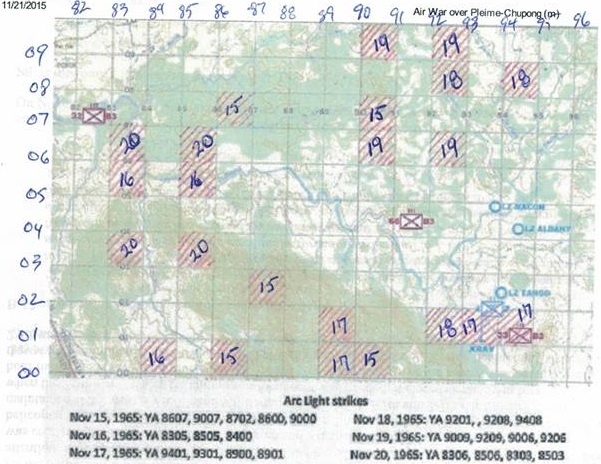
In summary, the Pleime-Chupong Arc Light operation was executed in five steps: 1/ interdict the attack at Pleime; 2/ repulse the attack to Chupong; 3/ prepare and fix the targets; 4/ strike; and 5/ finish off. The operation lasts 38 days and 38 nights from beginning to end.
What was the key element that had made the Pleime-Chupong Arc Light operation a notable success?
= The success of this Arc Light Pleime-Chupong campaign was made possible due to an accurate and solid real-time intelligence of the enemy military situation (Pleime, Trận Chiến Lịch Sử, page 94):
The battle from phases 2 and 3 also introduced an aspect never seen up to now because for almost 20 years, during the Franco-Vietnamese war, seldom pursuit operation was considered after each time the enemy made an appearance and when it was conducted, no significant results had been achieved. Therefore this time around, the determination not to allow the enemy to escape, coupled with the solid intelligence on the enemy situationhad permitted the battle to develop to the maximum degree and scale and at the same token lead to the biggest victory ever achieved by the ARVN and its Allied.
This solid intelligence was obtained by a unique method: the radio intercepts of Chine Advisors’ un-coded communications in Mandarin by the ARVN intelligence apparatus provided by the Taiwanese Government since the time of President Diem’s Government (Pleime, Trận Chiến Lịch Sử, page 124):
The natural corridors often mentioned by General Delange in 1951 would not be efficient without the existence of Cambodia, without the concealment of Red Chinese advisors who enjoyed full amenities living in Phnom Penh, without the excellent communication by ways of telephone and air-gram between Phnom Penh and Hanoi.
The Chinese Advisors, who were also embedded in the NVA forces at regimental level, conversed freely between them, unaware that their radio communications were eavesdropped by the ARVN intelligence teams. This intelligence source allowed II Corps Command to know precisely all B3 Field Front Command’s planning in real-time and to schedule accordingly the first B-52 strike’s time over target (TOT) set for 1600H on November 15 and to have the 1/7 Air Cavalry Battalion inserted at the footstep of Chu Pong Massif on November 14 to fix the targets for the B-52 strikes.
Unlike in the cases of other B-52 strike operations, the casualties caused by the Arc Light strikes were not assessed by sending in ground troops into the strike areas. They were provided by listening to the casualties reports of the Chinese Advisors themselves. It was why II Corps Command was so sure the enemy had lost 2/3 of their strength, after two days of B-52 strikes on November 17 (Why Pleime, chapter VI) :
The intelligence estimate on enemy capabilities, made on 17 November indicated that nearly 2/3 of their strength had been wiped off through the engagements in Phases I and II.
and to send in the Airborne Task Force into Ia Drang to finish off the operation.
How successful was the Pleime-Chupong Arc Light operation?
= General McChristian noted in his report (Intelligence Aspect of Plei Me/Chu Pong Campaign, page 67):
During the period between 15 and 22 Nov there were 14 B-52 strikes conducted in the area of operations in support of Operation Silver Bayonet. This was the first operation to make tactical use of the B-52, and a total of 76 B-52s dropped almost 3900 – 750 lb bombs in the vicinity of the Chu Pong base area. Later interrogation of a NVA captive revealed that the 1st and 3rd Bns of the 32nd NVA suffered 33% casualties during the encounter, the majority of which were due to B-52 strikes.
It is noteworthy to point out that General McChristian took the precaution to conceal the radio intercepts intelligence by naming as the source from the interrogation of NVA captive in this instance, or to captured documents in other instances (Intelligence Aspect of Plei Me/Chu Pong Campaign, page 41):
On 9 November 1965, a captured document listed the following casualties for the 33rd Regiment.
Nguyen Van Tin
13 March 2016
- Operation Pleime-Chupong B-52 Strike?
- The Use of B-52 Strike in Ia Drang Campaign, General Westmoreland’s Best Kept Military Secret
- Air War Over Pleime-Chupong
- Arc Light over Chu Pong Operation
- Catching a Thief Tactic in Pleime Campaign
- Pleime/Chupong Campaign Destroying B3 Field Front Base
- The Uniqueness in Pleime Counteroffensive Operational Concept
- Pleime Counteroffensive into Chupong Iadrang Complex
- The Unfolding of Strategic and Tactical Moves of Pleime Campaign
- Battle of Pleime
- The Truth about the Pleime Battle
- Intelligence Gathering at Ia Drang
- Intelligence, the Key Factor in the Pleime Campaign's Victory
- Roll Call of Combatants at Pleime-Chupong-Iadrang Battlefront
- "Victory at Pleime" ?
- Tactical Moves in Pleime Battle
- Kung Fu Tactics at Pleime Campaign
- Various Diversionary Moves in Support of Arc Lite Strike in Pleime Counteroffensive
- What if there was no master plan for Pleime Counteroffensive?
- Pleime/Chupong Campaign Destroying B3 Field Front Base
- A Few Things You Should Know about Pleime-Iadrang Campaign
- Things the VC Don't Want People To Know at Pleime Battle
- Reviewing "Why Pleime"
- Review of "Intelligence Aspects at Pleime_Chupong Campaign"
- Perplexing Maneuvers at Pleime-Chupong-Iadrang You Might Be Attempted to Question
- Operation Dan Thang 21
- US Air Force’s Roles in Pleime Campaign
- Arc Lite Operation Planning and Execution in Pleime Offensive
- A Doctrinal Lesson on the Use of Arc Lite in Pleime Counteroffensive
- Command and Control of Arc Light Strike at Chupong-Iadrang
- A Military Genius in Action at Pleime-Chupong-Iadrang Battlefront
- Command and Control Skills in Pleime Campaign
- Behind-the-scenes Activities at Various Allied Headquarters During Pleime Campaign
- The Two Principals Players Of Pleime Chess Game
- Pleime Battle's Diary
- Pleime Campaign and Pleiku Campaign
- A New Look at Ia Drang
- Operation Long Reach
- LZ X-Ray Battle (General Knowles)
- My Contributions to the Battle of Ia Drang in Wikipedia
- Operation LZ X-Ray
- Colonel Hal Moore’s Self-Aggrandizement in “We Were Soldiers Once ... and Young”
- Colonel Hal Moore Misunderstood his Mission at the Ia Drang Battle
- What Historians Failed to Tell About the Battle at LZ X-Ray
- Hal Moore and 1/7th Air Cavalry Battalion's Real Mission at LZ X-Ray
- Two Different Narrations of LZ X-Ray Battle by II Corps
- Ia Drang Valley Battle? Which One?
- LTC Hal Moore Summoned to a Woodshed Session?
- Colonel Hieu's Operational Concept for LZ X-Ray
- LZ Albany Battle - Chinese Advisors' Perspective
- A Puzzling Air Assault Performed by 1/7 Air Cavalry at LZ X-Ray
- Two Different Narrations of Than Phong 7 Operation by II Corps
- General Schwarzkopf's Naïveté In Ia Drang Battle
- Venturing into Lion's Den in Ia Drang Valley
- American Perspective of Pleime Battle
- General Kinnard's Naïveté in Pleime Campaign
- "No Time for Reflection at Ia Drang" ?
- Pleime Campaign or Pleime-Ia Drang Campaign?
- A Critique of General Bui Nam Ha's Opinions about Plâyme Campaign
- Commenting on General Nguyen Huu An's Account of Plâyme Campaign
- Crushing the American Troops in Western Highlands or in Danang?
- What Really Happened at Ia Drang Battle
- Case Study of a Typical Misinterpretation of Ia Drang Battle
- Ia Drang Battle Revisited
Documents
- Why Pleime
- Pleime, Trận Chiến Lịch Sử
- Pleime Battle Viewed From G3/I Field Force Vietnam
- Long Reach Operation Viewed From G3/I Field Force Vietnam
- LZ X-Ray Battle and LZ Albany Battle Viewed From G3/I Field Force Vietnam
- Than Phong 7 Operation Viewed From G3/I Field Force Vietnam
- Arc Light Strike at Chupong-Iadrang Viewed From G3/IFFV
- Pleiku Campaign
- Intelligence Aspects at Pleime_Chupong Campaign
- Excerpts of General Westmorland’s History Notes re: Pleime-Chupong-Iadrang Campaign
- LZ X-Ray Battle (General Knowles)
- LZ X-Ray After Action Report - LTC Hal Moore and Colonel Hieu
- Than Phong 7
- 52nd Combat Aviation Battalion in Support of Pleime Campaign
- CIDG in Camp Defense (Plei Me)
- Viet Cong Requested Red China's Aid
- Battle of Duc Co
- NVA Colonel Ha Vi Tung at Pleime-LZ Xray-LZ Albany
- The Fog of War: The Vietnamese View of the Ia Drang Battle
- No Time for Reflection: Moore at Ia Drang
- 1st US Cavalry Division Gives Support in the Battle at Plei Me
- Plei Me Fight Stands As War Turning Point
- Plei Me Battle
- Seven Days of Zap
- Pleime Through New York Times' View
- First Engagement With American Troops at Pleime-Iadrang
- Pleime Campaign
- Crushing the American Troops in Central Highlands
- NVA 66th Regiment in Pleime-Ia Drang Campaign
- The Political Commissar at the First Battle Against the Americans in Central Highlands